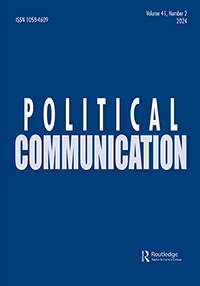Politicizing Masks? Examining the Volume and Content of Local News Coverage of Face Coverings in the U.S. Through the COVID-19 Pandemic
IF 5.1
1区 社会学
Q1 COMMUNICATION
引用次数: 0
Abstract
ABSTRACT The COVID-19 pandemic quickly became a political and health communication crisis whose impact varied by geographic location in the United States. Although local television is known to be an important source of public information, little is known about how it covered the pandemic. We analyze the volume and content of local TV coverage of masks from 758 stations across all 210 U.S. media markets in the first 22 months of the pandemic to assess how often news mentions masks and the extent to which mask wearing is framed as a contentious issue by highlighting controversy and partisan cues. Overall, we find widespread but variable attention to masks throughout the pandemic at levels frequently matching or exceeding the initial coverage of the CDC recommendation to wear face coverings. Controversial coverage of face masks peaks in late summer 2021 at roughly 23%, amid the rise of the new Delta variant, although partisan controversy comprises a relatively small portion of mask-related television news. Case rates, population size and density of the market, and partisanship of the local area are associated with volume and content of mask coverage, but these relationships vary over time. We also find evidence that stations owned by the Sinclair Broadcasting Group air fewer stories about masks and more controversy including partisan conflict in their mask coverage. The results add further support to the notion that the messaging surrounding COVID-19 on television varies in part based on geographic location and corresponding demographics but may also vary based upon ideological commitments of station owners.政治化的面具?考察2019冠状病毒病大流行期间美国当地新闻报道面部覆盖物的数量和内容
本文章由计算机程序翻译,如有差异,请以英文原文为准。
求助全文
约1分钟内获得全文
求助全文
来源期刊

Political Communication
Multiple-
CiteScore
13.90
自引率
2.70%
发文量
30
期刊介绍:
Political Communication is a quarterly international journal showcasing state-of-the-art, theory-driven empirical research at the nexus of politics and communication. Its broad scope addresses swiftly evolving dynamics and urgent policy considerations globally. The journal embraces diverse research methodologies and analytical perspectives aimed at advancing comprehension of political communication practices, processes, content, effects, and policy implications. Regular symposium issues delve deeply into key thematic areas.
 求助内容:
求助内容: 应助结果提醒方式:
应助结果提醒方式:


